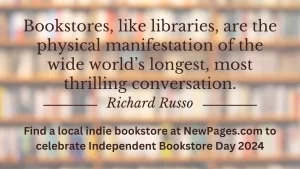Poetry Northwest – Summer/Fall 2016
Co-editor Aaron Barrell asks “And what force can a magazine of poetry have in this world?” and later promises that “each poem in these pages will offer sustenance.” I am inclined to agree. I would add to that the visual art on the pages of this issue of Poetry Northwest. Commanding and stunning, the images strike with a bold knowledge of beauty, joy, and heartbreak. Joe Wankelman’s photograph “Lines” arrests with cautious veracity. The works of photography and artwork in this issue are acute in their understanding of different realities.
Co-editor Aaron Barrell asks “And what force can a magazine of poetry have in this world?” and later promises that “each poem in these pages will offer sustenance.” I am inclined to agree. I would add to that the visual art on the pages of this issue of Poetry Northwest. Commanding and stunning, the images strike with a bold knowledge of beauty, joy, and heartbreak. Joe Wankelman’s photograph “Lines” arrests with cautious veracity. The works of photography and artwork in this issue are acute in their understanding of different realities.
The poems in this issue also deal in reality and the contemplation of heartbreak in a world bent on throwing us disaster after disaster. The poems are sustaining in their assured voices and reassuring in their tone regarding how the world is despite complicated relationships and unpredictable events. Michelle Penaloza assures us:
the ocean can attack an island from all sides
the volcano can break the earth beneath you
every single rooftop can be safe to walk upon
if your whole world is buried in lahar
These lines seem to follow the instructions from the universe in her first stanza that she “should trust / the moon / and scatter some faith / among the stars.” Michael Bazzett’s “The Temple” provides an answer to religion where God seems to have left the building; a modern addition to his temple could invite a visit. He wants “the temple / to hold more not less” and be:
beautiful
the way it was when I was a boy
and thought that god,
even if he did not actually live there,
might occasionally wander in
to check out the acoustics.
Paula Closson Buck’s faith in art as transcendence is shattered in “The Octopus Prophet” in the realization that “there was no afterlife / though all the hatches were flung open, / all the sorry bones unpacked for eternity.” In this poem both art and religion have failed to satisfy despite the efforts of the speaker to see “a new Heaven / and a new Earth.” In all of these poems, the imagery and controlled lines are essential in relating what knowledge and perhaps even optimism can be gleaned from disappointment.
The translations in this issue offer vibrant language emanating from texts by Corrado Govoni, Martial, Valerie Mejer Caso, Blanca Varela, and Mario Luzi. Paula Bohince’s translation of Govoni’s “Le rane”/“Frogs,” maintains the crepuscular quality in precise imagery as in the following lines:
The melon-yellow moon
is tipped behind poplars,
ashy clouds like packs of dogs,
volcano of the violet sky.
Tyler Goldman compares Martial’s epigrams to tweets in that they “find ways to pack large punches in very small spaces.” His translations bring the verse of the first-century Roman poet to the present in such lines as:
Poor right now, poor always, buddy.
These days only the rich make money.
Michelle Gil-Montero’s translation of Valerie Mejer Caso’s “This Happened on a Record and It Is Also a Song” is a dreamlike scenario that, like much of her poetry, as stated in her bio, “explores containment and fragility, layering loss and possibility over a once-familiar landscape.” The following lines from this poem remind me of Octavio Paz’s use of contrasts to create reality but in Caso’s unique voice:
As for me, I’m on
edge every night, every time I dream that I find a heart on
the street and, by chance, I know it’s mine. I pick it up. I put
it in a bag and bring it to the emergency room. The Milky
Way, which I never think about, perched over the city. And
I read that your heart, newly born in a poem, is thumping
as fast as a rabbit’s, next to a bloodless humanity.
In every work translated in this issue, images surprise and offer themselves up for insight and perception. If readers only read the translations in this issue, they will not be disappointed, but I would urge them to read the issue from cover to cover. The abundance of language in lines and stanzas in all of the poems convey weighty truths through genuine observation.
Matt Terhune’s “Apparition” is a solemn reminder of how so many deal with loss and grief. He imagines “the dead walking among us, not on high, sunning in / the solar canopy, / playing house among the furniture in the clouds, but here / in the earth’s basin.” Akin to this feeling of loss is the theme of Kaveh Akbar’s “Before You Left on Your Journey Which Has Kept You Away for So Long,” in which the speaker explains to the person who has left that “the vanishing has widened” and “there is a tender rot in everything” among the other mournful lines in the poem. Both poems are illustrative of feelings of loss so prevalent in these times.
When co-editor Erin Malone writes “here are poems that consider ideas of God, fortune, drift, and home,” she is helping readers enter the world of the poets and artists in this issue with the hope that poetry still matters. In this issue, it most certainly does.
[www.poetrynw.org]





